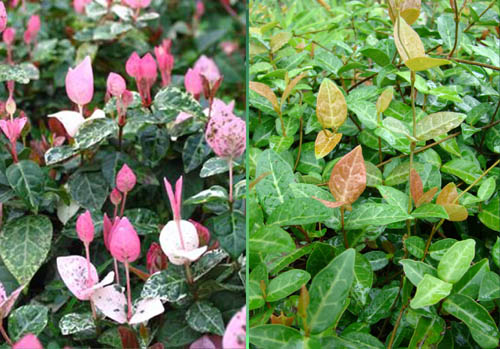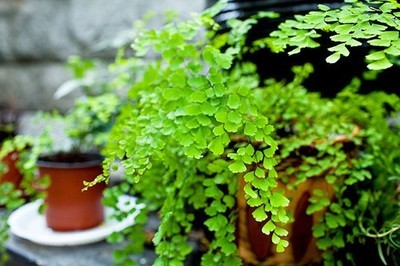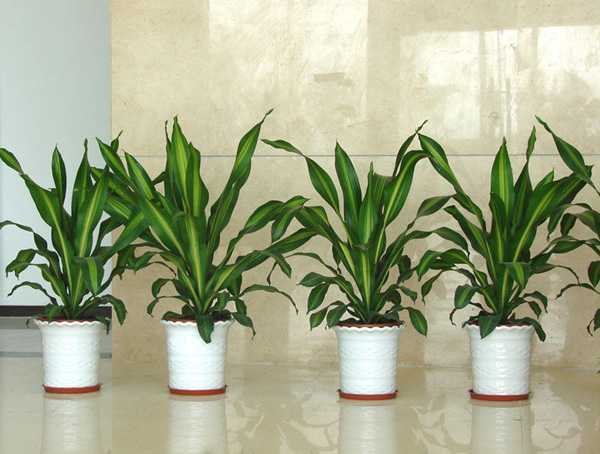The culture method of flower leaf stone the picture of flower leaf stone
Huaye Luoshi is an evergreen woody vine with inconspicuous lenticels in its stem. Branchlets, young petioles and leaves abaxially pubescent, old branches and leaves glabrous. It is a light-loving, strong shade-tolerant plant and likes the environment with high air humidity. it can be used as a perennial "flowering" plant for various flower mirror arrangements. at the same time, it is also an excellent potted plant material. Evergreen woody vine with stems with inconspicuous lenticels. Branchlets, young petioles and leaves abaxially pubescent, old branches and leaves glabrous. Leaves leathery, elliptic to ovate-elliptic or broadly Obovate, 2-6cm long and 1-3cm wide. The old leaves are nearly green or light green, the first round of new leaves are pink, a few have 2-3 pairs of pink leaves, the second to the third are pure white leaves, and there are several pairs of variegated leaves between pure white leaves and old green leaves. Next, the editor of the net will introduce Huayeluoshi to you.

The culture method of flower leaf stone the picture of flower leaf stone
Growth habit
Huaye Luoshi is suitable for survival in acidic and neutral soil environment with good drainage, strong disease resistance and exuberant growth, similar to Chinese native collaterals, but also has strong drought resistance, short-term flood resistance and cold resistance. The change of leaf color is related to light and growth status, and bright color performance needs good light conditions and exuberant growth conditions.
From the perspective of experimental cultivation, the change of leaf color is related to light and growth status, and the bright color performance requires sufficient light conditions and exuberant growth conditions, but at this time, the plant growth is not fast, and the growth of the growth month is mostly about 3cm. In terms of its own plant growth, it is a light-loving, slightly shade-tolerant plant, likes the environment with high air humidity, acid and neutral soil with good drainage, strong sex, fast growth, and the monthly growth rate of the growth month can reach more than 4cm. At the same time, it is also a drought-resistant and cold-tolerant variety.
Huaye Luoshi can be propagated by cutting in any season of the year, and the rooting rate can reach more than 98% in spring and autumn. Cutting in summer is easy to rot some branches that grow too young, but branches that are semi-lignified can take root and survive. In addition, mosaic collaterals can also be striped to reproduce.
Generally, the old branch is pressed in early spring, and the tender branch is pressed in summer, about 3cm is buried in the soil, and both nodes and internodes can take root to form a new plant, but the propagation rate of strip propagation is not fast, and the amount of labor is large, so it is difficult to apply in large-scale production. The technique of rapid propagation of mosaic collaterals in tissue culture has been completed, flowers and leaves can appear in the process of tissue culture, and the ornamental characters are stable.
According to the double consideration of its growth and ornamental value, the cultivation of mosaic stone can properly distinguish between seedling production, plant cultivation and the cultivation of finished seedlings, that is, mass propagation and early plant cultivation under the most suitable environmental conditions, such as semi-sprouting, loose and fertile cultivation substrate, and when the plant reaches 20cm length and more branches, it is cultivated under strong light conditions, in order to achieve bright leaf color.
The extremely beautiful ground cover plant material can be planted in the isolation zone under the urban street trees. Or covered with vines as slope protection. It can replace the potted flower scenery in parks and modern facilities, so as to overcome the high cost of short viewing period and frequent replacement of potted flowers. In addition, it can also be used as an excellent plant for family potted plants, or as a landscaping plant for moss micro-landscape.
The ornamental value of Huaye Luoshi is reflected in three levels of leaf color, that is, the color group composed of red leaves, pink leaves, pure white leaves, variegated leaves and green leaves, very much like a cluster of flowers in full bloom, extremely gorgeous and colorful, especially in spring, summer and autumn. That's all for today's editor's introduction to the method of flower and leaf stone culture. Thank you for your appreciation.
How to raise the flower and leaf stone and the culture method of the flower and leaf stone
Huaye Luoshi is an evergreen woody vine with inconspicuous lenticels in its stem. Branchlets, young petioles and leaves abaxially pubescent, old branches and leaves glabrous. It is a light-loving, strong shade-tolerant plant and likes the environment with high air humidity. it can be used as a perennial "flowering" plant for various flower mirror arrangements. at the same time, it is also an excellent potted plant material.
Growth habits of mosaic collaterals
Huaye Luoshi is suitable for survival in acidic and neutral soil environment with good drainage, strong disease resistance and exuberant growth, similar to Chinese native collaterals, but also has strong drought resistance, short-term flood resistance and cold resistance. The change of leaf color is related to light and growth status, and bright color performance needs good light conditions and exuberant growth conditions.
The culture method of mosaic stone (growth and differentiation) 1. Acquisition of aseptic materials
Select the mother plant of annual seedling without disease and insect pests, cut the tip of spring shoot in the same year, remove the leaf, retain the petiole, and cut the branch into 2-3cm segments. When disinfecting, soak 15min with 10% detergent solution, then wash 30min with running water. Under sterile conditions, soak in 75% ethanol solution to sterilize 30s, add 0.1% mercuric solution and Tween-20 to sterilize 3,5,10 and 15min. The sterilization effect of 0.1% liter mercury solution increased with the extension of sterilization time, the sterile vaccine acquisition rate was less than 13.5% if the sterilization time was less than 10min, the sterile vaccine acquisition rate of sterilization 15min "was 23.7%, and the explant mortality rate was 33.3%. With the extension of sterilization time, the toxic effect of mercury on plant materials is intensified, and the sterilization time of 0.1 liter mercury solution 10-15min is appropriate. Wash it in sterile water for 5 times, then inoculate it on MS solid medium.
two。 Bud induction
When the sterile seedlings 20 days after inoculation were transferred to the medium (1), the stem tips began to germinate at 7 days, the axillary buds germinated at 10 days, and the buds grew gradually. After 20 days of culture, all the axillary buds on the stem segments germinated into lateral branches. The lateral branches grow normally, the leaves are dark green, and the callus at the base of the stem is less, yellowish green.
3. Proliferation of test-tube plantlets
The lateral branches of test-tube plantlets were divided into 2 murine buds and 3 buds and inoculated on the medium (2). After 10 days, the leaf buds of stem segments germinated, and a large number of lateral branches grew in 30 days, and a large number of twin branches and tertiary branches were produced. The tufted seedlings with 8 lateral branches of 5 Mel were formed after inoculation, and the average multiplication was 5.8 times. The internodes of test-tube plantlets elongated obviously, the stems of young leaves were reddish, the leaves were large, the stems were thick, the tissue was not substantial, and the callus at the base of the stem was large. After subculture once every 30 days, vitrification occurred in test-tube plantlets subcultured for 4 times after 3-Mel.
4. Strong seedling culture
The test-tube plantlets cultured by proliferation were subcultured for 4 times and then transferred to the medium (3). After 40 days, a large number of lateral branches were formed, with an average of 6 lateral branches per stem segment, the average length of lateral branches was 1.8cm, and the average proliferation was 3.1 times. There are almost no twins or triplets. The lateral branch grows healthily, D, the tissue is abundant, the leaf color is dark green, the basal callus is small, yellowish green, and there is no vitrification.
5. Root induction
The lateral branches with robust growth and longer length than 1.2cm were divided and transferred to medium (4). Increase the light intensity to 2500-3000lx and prolong the light time to 16 hours a day. The root primordia began to form after 15 days of culture, and the seedlings could be refined after the formation of root primordia. 20Mel 25 days to investigate the rooting situation, the rooting rate was 73%, and the average rooting of each seedling was 2.
6. Seedling refining and transplanting
The rooting test-tube plantlets were transferred to the greenhouse with bottles and cultured for 1 week. When the root length is 0.5 omb inch, open the bottle cap to refine the seedlings for 5 days, take out the rooting seedlings, wash the root culture medium, and plant them in the seedling hole plate. With black mud carbon as the matrix, the temperature is controlled between 20 ℃ and 25 min, and the humidity is 85% 95%. It can survive in 20 days, and the survival rate is more than 73%.
Mosaic stone diseases and insect pests 1. Mosaic stone diseases
The diseases of mosaic collaterals are mainly caused by leaf spot and anthrax.
Prevention and cure method
When mosaic mosaic occurs leaf spot and anthracnose, it can be controlled with 800 × 1000 times of 70% mancozeb wettable powder or 600 times 800 times of 50% methyl topiramate.
2. Insect pests caused by flowers and leaves
The harm of moth larvae
Mosaic collaterals are sometimes injured by moth larvae, which mainly occurs from June to September every year. Can be trapped before spawning, and timely chemical control, spraying 5% cypermethrin EC 1000-2000 times or 1% avermectin EC 2000 times, should be carried out in the evening. At ordinary times, we should pay attention to maintaining the ventilation of the environment.
The harm of nematodes
For mosaic stone, nematode is also a pest that has to be prevented. When mosaic collaterals give birth to nematodes, drugs can be used to disinfect the soil and kill nematodes with 2000 times the solution of 40% clenophos EC. Give priority to prevention and combine prevention with prevention.
The harm of aphids
Aphids are very common pests of mosaic collaterals. Aphids will suck the juice of mosaic collaterals in the young part of mosaic collaterals, endangering the health of mosaic collaterals. When aphid damage occurs in mosaic stone, it can be controlled with 48% Lesbon EC 2000-3000 times or imidacloprid 25 wettable powder 1500 times. It is necessary to give priority to prevention, supplemented by treatment, and reasonably control aphids.
How to raise flower and leaf collaterals? Culture methods and matters needing attention of Huaye Luoshi
Huaye Luoshi, also known as early kudzu, spotted leaf Luoshi, etc., is a woody vine of the oleander family. The leaves of Huaye Luoshi are rich in color, which is composed of red leaves, pink leaves, pure white leaves, variegated leaves and green leaves, which has good ornamental value. So, how to raise the flower and leaf stone? Now the breeding methods and matters needing attention of Huaye Luoshi are introduced as follows.
Picture: Hua Ye Luo Shi
I. the culture method of Hua Ye Luo Shi
1. Fertilizer: Huaye Luoshi likes fertilizer, but it is not demanding. All kinds of fertilizers can be used. It can blossom without fertilization for a year, but the amount of flowers is less. Potted flowers and leaves in order to make the flowers like brocade, you can apply more bone powder and phosphorus and potassium fertilizer, less nitrogen fertilizer. The compound fertilizer of nitrogen, phosphorus and potassium can be applied once in spring and autumn, but not in winter and summer.
two。 Watering: Huaye Luoshi likes to be moist, the basin soil should be slightly moist during the growing season, watered once every two days in spring and autumn, once a day in summer, and once every half a month in winter. The basin soil is slightly moist and can not be watered at any time. Potted flowers and leaves placed in the roof garden or courtyard should pay attention to the discharge of stagnant water in the rainy season, and do not plant them in low-lying land, otherwise the roots will rot easily, and it is not too late to see the soil dry and water again in the growing season, but not in winter.
3. Pruning: flower and leaf collaterals are resistant to pruning, evergreen all the year round, and can also be used with golden leaf privet and red leaf Berberis for color block greening. Controlling the length of rattan by pruning can promote branching and is beneficial to the fullness of plant type. The first pruning when the vine reaches 8 cm in length, leave about 6 cm to cut off, and then prune every 4 cm to 5 cm, usually pruning 2 cm 3 times to have a good basin shape.
Picture: Hua Ye Luo Shi
4. Lighting: flowers and leaves are temperate flowers, like warm and light, the ground should be planted in the sun, poor growth in the shade, few flowers, light fragrance, or even no flowers. Potted plants should be placed in a sunny place in spring, autumn and winter. In midsummer, if you can see the sun in the morning or evening and avoid the strong light at noon, the flowers will bloom continuously. If you get too much sun at noon, there will be few or no flowers. Luoshi is more hardy. In the Yellow River basin and its south, it is safe to winter outdoors. In the north, it is better to winter in a low greenhouse.
5. Diseases and insect pests: mosaic collaterals diseases are mainly anthracnose and leaf spot, etc., with 50% methyl thiophanate 600 × 800 times solution or 70% mancozeb wettable powder 800 times solution. The harm of red spiders and other mites and moth larvae was controlled by 15% chlorpromazine 1000-1500 times. Aphids were treated with imidacloprid 25% wettable powder 1500 times or 48% Lesbon EC 2000-3000 times.
Picture: Hua Ye Luo Shi
II. Matters needing attention in mosaic stone culture
1. Soil: loam which is loose and fertile and high in humus is the best. In the process of seedling and finished seedling cultivation, it should be treated differently according to the production target.
two。 Water and fertilizer: mainly apply nitrogen fertilizer, foliar spraying fertilizer or irrigating roots to increase growth; it can also be fertilized from March to August, which will promote the growth of the plant, and it can be fertilized properly from September to the first ten days of October to promote the health of the plant.
Picture: Hua Ye Luo Shi
3. Pruning: it will be banned from pruning in October.
4. Diseases and insect pests: the flowers and leaves are brightly colored and are vulnerable to aphids, so it is necessary to do a good job in aphid control.
[editor's conclusion] Huaye Luoshi is a plant that likes light and less shade tolerance, likes the environment with high air humidity, and needs special attention in the process of maintenance. The above introduces the breeding methods and matters needing attention of Huayeluo stone. I hope it can be helpful to everyone!
- Prev

The Culture method of Dryopteris Dryopteris
Among ferns, Dryopteris is one of the most popular cultivated species. Beautiful stems and leaves, beautiful shape, small plant type, very suitable for small pot cultivation and embellished with mountain and stone bonsai. Because the black petiole is slender and shiny, very similar to human hair, plus its texture is very soft, like a girl's soft hair
- Next

Thread iron breeding methods and precautions Thread iron pictures
Why is it called that? It may have something to do with its shape. If you are a newly renovated house, it is also good to put a pot. Alias: spiral iron, willow iron, Philippine iron tree, leaf iron, twisted iron
Related
- Fuxing push coffee new agricultural production and marketing class: lack of small-scale processing plants
- Jujube rice field leisure farm deep ploughing Yilan for five years to create a space for organic food and play
- Nongyu Farm-A trial of organic papaya for brave women with advanced technology
- Four points for attention in the prevention and control of diseases and insect pests of edible fungi
- How to add nutrient solution to Edible Fungi
- Is there any good way to control edible fungus mites?
- Open Inoculation Technology of Edible Fungi
- Is there any clever way to use fertilizer for edible fungus in winter?
- What agents are used to kill the pathogens of edible fungi in the mushroom shed?
- Rapid drying of Edible Fungi

